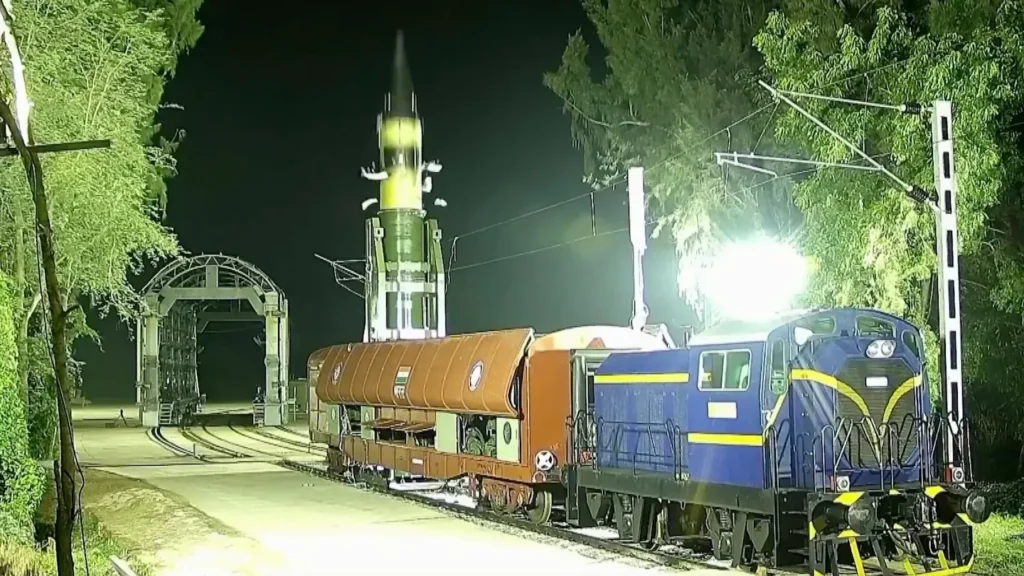Agni on the Move: India’s Incredible Missile Test from a Train
Earlier, only a few countries like USA, Russia, China, and North Korea had the capability to launch advanced missiles with mobility. But now, after India successfully tested its Agni-Prime missile from a rail-based mobile launcher, the country has joined this elite group of nations with such strategic capabilities.
Yes, I am talking about the missile test from a moving train, but naturally, a few questions arise:
- If India already has advanced missile carriers, why test from a train?
- What are the benefits of this system?
- Are there any challenges involved?
This test opens up a lot of interesting points to discuss about India’s defense technology, strategic advantage, and future readiness.
Rajnath Singh’s Reaction
Following the successful test, Defence Minister Rajnath Singh praised the achievement, calling it a milestone in India’s strategic capabilities. He congratulated DRDO, the Strategic Forces Command, and the Armed Forces for making India one of the few nations in the world to launch a canisterised missile system from a moving rail platform.
Rajnath Singh highlighted that the Agni-Prime, with its 2000 km range and advanced features, not only strengthens India’s deterrence but also showcases the country’s growing self-reliance in defense technology. According to him, the ability to launch missiles from a rail-based mobile system with quick reaction time and reduced visibility gives India’s armed forces a flexible and powerful edge in modern warfare.
Why India is Testing Missiles from Trains: The Strategic Advantage of Rail-Based Systems
India’s recent test of launching missiles from trains has sparked curiosity. After all, we already possess advanced land-based missile carriers and naval launch systems. So why add a train-based option? The answer lies in mobility, survivability, and strategic redundancy.
1. Mobility and Survivability
Fixed land-based launchers, while powerful, are stationed at known bases and are vulnerable if their locations are compromised. Train-based launchers, however, can traverse hundreds of kilometers across rail networks, making them harder to track and target. In times of conflict, this mobility dramatically increases their survivability.
2. Strategic Flexibility
Trains can reach regions where road access may be limited or terrain is difficult for conventional missile vehicles. They can also launch from unexpected locations, adding an element of unpredictability to India’s defense posture.
3. Cost-Effectiveness
Leveraging existing railway infrastructure is often cheaper than constructing new road-based launch systems in remote areas, making it an efficient choice.
4. Complementing Other Systems
While sea-based missile systems provide excellent deterrence, they rely on naval presence and operational control. Train-based systems add a redundant layer if land or sea assets are compromised, trains can still operate, ensuring India maintains a robust second-strike capability.
In simple terms, train-based missile systems are like a backup plan within a backup plan providing mobility, surprise, and survivability that fixed land systems and ships alone cannot guarantee.
Historical Precedents: Who Tried Rail-Mobile Missiles?
Soviet Union / Russia – The clearest real-world example. During the Cold War, the USSR developed the RT-23 (SS-24) family of rail-based ICBMs. Hidden inside railcars that resembled ordinary freight trains, these missiles were extremely difficult to detect. After the Cold War, arms-control treaties led to the system’s retirement and dismantlement.
United States – The U.S. explored rail-based missile concepts, including a “Peacekeeper rail garrison” during the Cold War. Though technically feasible, high costs, treaties, and evolving strategies prevented widespread deployment.
Other Countries – Some nations experimented with rail or road-mobile missile concepts, but the Soviet/Russian program remains the most operationally significant example.
Why Rail-Based Missiles Were Considered
- Survivability / Second-Strike Assurance – A missile moving continuously on a vast rail network is extremely hard to locate and neutralize.
- Concealment / Camouflage – Trains can blend with civilian rail traffic, complicating enemy surveillance.
- Mobility + Deployment Range – Rail networks reach regions that road-mobile launchers may find inaccessible.
- Cost Leverage of Existing Infrastructure – Rail lines and yards reduce the need for dedicated hardened sites.
- Political / Strategic Signaling – Multiple basing modes (silo, road-mobile, sea, rail) complicate enemy planning and demonstrate capability breadth.
Why Most Countries Stopped Short
- Dependence on Rail Infrastructure – Trains are limited to tracks, bridges, and tunnels, creating potential vulnerabilities.
- Logistics & Security Complexity – Protecting depots, maintenance, fuel, and specialized railcars is costly and cumbersome.
- Predictability of Movement – Repeated routes can be observed, reducing stealth.
- Arms-Control and Political Constraints – Rail ICBMs were often restricted under treaties.
- Modern Alternatives – Submarines (SSBNs) and road-mobile launchers now provide better survivability with fewer constraints.
The Bottom Line
Rail-based missile systems, despite challenges, offer an extra layer of deterrence. By testing this technology, India demonstrates technical prowess and ensures strategic redundancy: even if land or sea systems are neutralized, train-based systems can keep the nation’s missile arsenal operational. For countries with extensive rail networks and the desire to disperse forces inland, this approach remains a valuable, though complex, strategic option.
Technical Features of Agni-Prime
The Agni-Prime missile is designed with advanced technology, giving it next-level capabilities in mobility, precision, and strategic use:
- Lighter Weight: Agni-Prime is 50% lighter than Agni-3, making it easier to move and launch from a rail-based mobile platform.
- High Accuracy: The missile can maneuver during atmospheric entry, making it difficult for enemies to intercept.
- Canisterised Launch System: Its flexible launch system allows the missile to be moved and launched secretly across the rail network.
- Two-Stage Solid-Fuel Propulsion: Advanced solid-fuel propulsion ensures fast, stable, and reliable launches.
- Advanced Navigation: Equipped with an inertial navigation system using ring-laser gyroscopes, Agni-Prime can precisely track its location and trajectory.
These features make Agni-Prime a highly mobile, hard-to-intercept, next-generation missile, significantly strengthening India’s strategic deterrence.
Conclusion
India’s successful Agni-Prime test from a rail network is not just a technical achievement—it’s a strategic milestone. It demonstrates that India’s defense technology is modern, mobile, and unpredictable.
The train-based launch system allows the missile to be secretly moved and launched quickly, enhancing the country’s survivability and rapid response capability.
This test sends a strong message: India is fully prepared to protect its borders and national security, and with this technology, it firmly strengthens its position among the world’s top nations with advanced missile capabilities.
Sources –
PIB
https://www.pib.gov.in/photshare/192203_3_1_photoshare.aspx. Press Information Bureau
DRDO — Press release page about Agni-Prime
https://www.drdo.gov.in/drdo/press-release/new-generation-ballistic-missile-agni-prime-successfully-flight-tested-strategic





